About Lythgo’s Row
William Lythgo was transported to Australia after being convicted of pick-pocketing. After he was granted his ticket-of-leave (parole) he become a police officer and was stationed at Pontville. The police station was situated on the land adjoining to this property (to the north) and the foundations of the station are still visible in the heritage listed ‘police paddock’.
The Pontville Bridge next to Lythgo’s Row was completed in 1842. It was built from sandstone quarried from the site on which Lythgo’s Row now sits. Wisely, William Lythgo saw the site as ideal for a home and business. He purchased the site and surrounding land on the hill behind and began the building in 1845.
The original Georgian structure was an 8 room, 2 storey building with a general store onsite. It was built in 1845. Take note of the windows on either side of the door to reception. The one on the right is larger and was used to serve through. The main road was actually the driveway of Lythgo’s Row and was known as Bridge Street. The northern approaches to the bridge can be seen to curve towards ‘Bridge Street’. In 1955 the bridge and highway were raised. The original pylons remain. Lythgo named the complex Lythgo’s Stores comprising of a butcher shop where Claude’s Cottage now stands and a blacksmith shop where the guest car park is located.
Next, the cottages were built some 7 metres north of the original house. These were built as workers cottages and were never an army barracks. The gap between the two buildings was filled in and the large front room (now the lounge room of owners house) became the general store and the room behind it the storeroom (now the dining room). The building as it is today was fully completed by 1855. Lythgo changed the name to Lythgo’s Row and renamed it again to ‘The Row’. The general store remained in operation until the 1950's. Over the years the building complex has had several functions and names. One was Riverain (Welsh for ‘house by the river’) and another The Barracks when it was mistakenly thought to have been an army barracks. Be sure to inspect the plaque over the front door of the residence.
When the Giddings family bought the building in 1985 it was divided into 5 flats which were in a derelict state. The family restored the building as a family home with 3 cottages for casual accommodation. The property traded as a Bed & Breakfast up until 2015. Following a period of neglect the property was purchased by the current owners in 2018 and a total refurbished commenced.
This is a snippet of the history of Lythgo’s Row and Pontville as we know it. We welcome you to come and explore our little historic town further.
About Pontville
The tiny village of Pontville is located 29 km north of Hobart on the Midlands Highway. Just one kilometre from Brighton, it became an important stopping point on the road from Hobart to Launceston in the 1830’s and effectively replaced Brighton, which at one time, had been promoted as a possible future capital of the island. From this time on it became one of the major suppliers of stone for the whole southern region of Tasmania.
The area around Pontville was first explored by Europeans in early 1804. By 1806, with serious food shortages in Hobart Town, expeditions of soldiers were being sent into this area to hunt kangaroos and emus. It is claimed that during one of these expeditions Private Hugh Germain, a well educated member of the Royal Marines, started giving various local sites exotic names. Thus, only a few kilometres north of Pontville lies the incongruously named village of Bagdad, and Pontville is actually situated on the banks of the equally incongruously named, Jordan River. It is said that Germain traveled through the area with a copy of the Bible and Arabian Nights and delighted in giving places names like Jerusalem, Jericho, Jordan and Lake Tiberius. In fact the headwaters of the Jordan River rise in Lake Tiberius before flowing through Jericho.
By the 1820's there was a small settlement at Pontville but the real development of the village occurred in the 1830's and 1840's when it took over from Brighton and became a major centre for the district and an important travellers stopping point on the road between Port Dalrymple (Launceston) and Hobart.
Pontville was developed on land which was originally owned by William Kimberley. In 1838 this land was sold and a number of important buildings - Police Station (1839), Courthouse (1842) - were constructed.
By the mid 1840's the town was thriving with a population of over 2000 people. By the 1860's there were six flour mills operating in the area.
Although the towns growth occurred in the 1840’s many of the old buildings predate this period of development.



